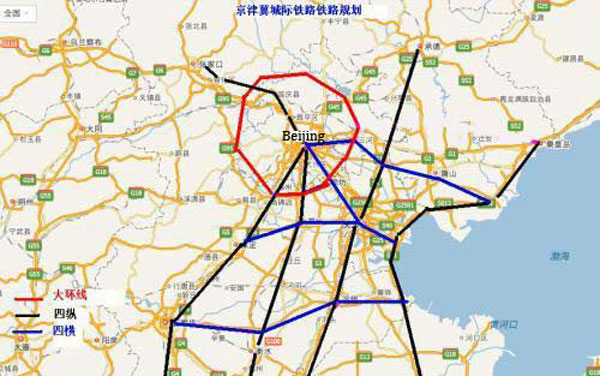 |
|
Legend: Red line - Loop railway line around Beijing; Black lines - Four vertical railway lines linking Beijing, Tianjin municipality and Hebei province; Blue lines - Four horizontal railway lines linking Beijing, Tianjin municipality and Hebei province |
Twenty-four intercity railway lines running over 3,453 kilometers with an investment of roughly 615 billion yuan ($97 billion) will be built by 2050 to link Beijing-Tianjin-Hebei region, the Beijing News reported on Thursday.
The network will have "four vertical lines, four horizontal lines and a loop line", covering the major cities, key towns and main industrial zones in the region with Beijing, Tianjin and Shijiazhuang, capital city of North China's Hebei province, as core cities.
Four vertical lines will be Beijing-Shijiazhuang-Handan, Beijing-Bazhou-Hengshui, Tianjin-Chengde-Cangzhou, and Qinhuangdao-Binhai-Binzhou, and the four horizontal lines will be Beijing-Tianjin-Yujiapu, Beijing-Xianghe-Tangshan-Caofeidian, Tianjin-Bazhou-Baoding, and Shijiazhuang-Cangzhou-Huanghua.
The loop line around Beijing will start from Beijing Daxing International Airport, which is under construction, and link Hebei's Langfang, Hebei's Xianghe, Beijing's Pinggu, Beijing's Miyun, Hebei's Huailai, and Zhuozhou city in Hebei province.
Among them, eight intercity railways, including Chongli section of Beijing-Zhangjiakou railway serving the 2022 Winter Olympics, will be built as of 2020 with an investment of 193.2 billion yuan so as to shift some non-capital functions and industries from downtown Beijing to suburban areas, and neighboring Hebei province and Tianjin municipality.
The construction of the rest 16 railways will be completed by 2050, according to a report released by The Third Railway Survey and Design Institute Group Corporation.
The report also shows that the integrated region of Beijing, Tianjin and Hebei province has been divided into four areas: The Central Core Functional Area, the Eastern Coastal Development Area, the Southern Functional Exploration Area, and the Northwestern Ecological Reserved Area.
Cities and towns with more than 50,000 residents in the Core Functional Area and cities and towns with more than 100,000 residents in the Eastern Coastal Development Area and the Southern Functional Exploration Area will be linked with intercity railways by 2020, while cities and towns with more than 50,000 residents in the Eastern Coastal Development Area and the Southern Functional Exploration Area will be linked by 2050.
Travel time between major cities in the Central Core Functional Area, which includes Beijing, Tianjin, Hebei's Langfang and Baoding, will be kept between half an hour and one hour, and the travel time between the major cities in the integrated region will be between one and two hour, while the commuting time between the urban areas and surrounding towns will be between half an hour and one hour.
The railway plan is another move to promote regional integration following the roaming fees scrapped for long-distance mobile calls in Beijing-Tianjin-Hebei region on Aug 1, 2015.
